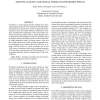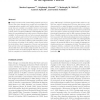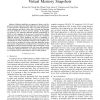138 search results - page 18 / 28 » Damage control |
ICASSP
2011
IEEE
12 years 11 months ago
2011
IEEE
Dysarthria is a motor speech disorder resulting from neurological damage to the part of the brain that controls the physical production of speech and is, in part, characterized by...
ISER
1995
Springer
13 years 11 months ago
1995
Springer
Most robot designers make the mechanical interface between an actuator and its load as stiff as possible[9][10]. This makes sense in traditional position-controlled systems, becau...
JOCN
2011
13 years 2 months ago
2011
■ Changes in brain activity characterizing impaired speech production after brain damage have usually been investigated by comparing aphasic speakers with healthy subjects becau...
INFOCOM
2010
IEEE
13 years 6 months ago
2010
IEEE
Abstract—Malicious shellcodes are segments of binary code disguised as normal input data. Such shellcodes can be injected into a target process’s virtual memory. They overwrite...
ECRTS
2007
IEEE
14 years 1 months ago
2007
IEEE
Today’s CPUs consume a significant amount of power and generate a high amount of heat, requiring an active cooling system to support reliable operations. In case of cooling sys...



